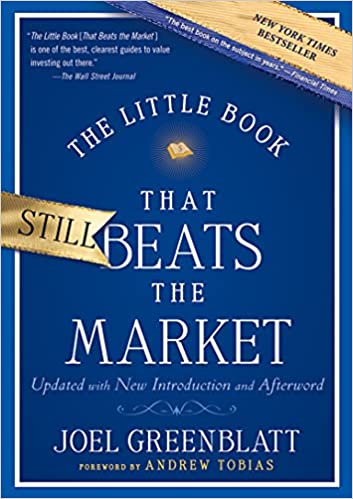The Little Book That Still Beats the Market — Book Summary
Introduction
Joel Greenblatt creates a simple, relatable book to guide you through what should be a more complicated process. This book takes you through steps to execute a simple formula to buy shares in excellent businesses (ones with a high return on capital), but only at bargain prices!
Interesting quotes from the book
Although, over the short term, Mr. Market may set stock process based on emotion, over the long term, it is the value of the company that becomes important to Mr. Market.
— Joel Greenblatt, The Little Book That Still Beats the Market
After more than 25 years of investing professionally and after 9 years of teaching at an Ivy League business school, I am convinced of at least two things: 1. If you really want to 'beat the market,' most professionals and academics can’t help you, and 2. That leaves only one real alternative: You must do it yourself.
— Joel Greenblatt, The Little Book That Still Beats the Market
Over the short term, Mr. Market acts like a wildly emotional guy who can buy or sell stocks at depressed or inflated prices. Over the long run, it's a completely different story: Mr. Market gets it right.
— Joel Greenblatt, The Little Book That Still Beats the Market
Summary of the book The Little Book That Still Beats the Market
This book distills valuable investment wisdom and strategy into simple words that anyone can understand at all, even a kid. It starts off with a fun story about a sixth-grade kid that sells gum and then segues into the focal point of the book - teaching everyone, even newbies, how to invest, in very simple terms.
It first starts with things you can do with your money. You could spend it (an interesting anecdote about a hot-air balloon really drove the point home). You could keep it with you ('under the mattress' as the book calls it), but this is not really a good idea because of inflation. Put it in the bank or buy government bonds (which he described as lending to the government) risk-free. Also buy bonds sold by companies and other groups, which usually has more reward, but there is also the risk that you could lose some or all of your money.
The next chapter starts off with one more thing you could do with your money: investing in a business (or buying a share in a business). Buying a share essentially means purchasing a portion or percentage interest of that business, entitling you to a percentage of the profits. Buying shares is a great way to get more value for your money compared to maybe buying government bonds (which are usually always fixed). To do this, one has to estimate how much a business is worth by trying to estimate how much a business will earn in the future.
Chapter Four starts off with the point that estimating a business' future earnings is difficult, especially because the prices of a company's shares in the stock market usually swing from a low value to a high one, sometimes in mere hours. The author references Benjamin Graham and his Mr. Market anecdote to note that in buying shares, it is a good idea to buy shares at a large discount from your estimated value of those shares (resulting in a high margin of safety and safer and more profitable investments). However, knowing or estimating the value of a company is difficult for many people, so it is hard to know when the price is right to purchase shares at a large discount.
The next chapter teaches that in order to invest profitably, two things are key. First is buying shares in a 'good company' is a good idea. An excellent company is one that has a high return on capital, which is the profit a company gets when compared to the amount of capital it put in. The higher the return on capital, the better the company. The second is buying shares in these good companies only at bargain prices (to give you a higher interest on what you invest or 'earnings yield').
The next chapter then goes into the 'magic formula' the author seeks to teach us. He first references Ben Graham and his own magic formula, which is that he only bought shares in companies at an extremely low bargain, giving him higher profits and low risk. This may not be so effective today because that 'magic formula' was used during the Great Depression, a period where many stocks were cheap because of economic decline. Those conditions do not exist today. The author then comes up with a new formula suitable for today's stock market conditions. Buying shares in excellent businesses (ones with a high return on capital), but only at bargain prices (to result in a higher earnings yield). The author then breaks down the formula. The formula lists companies, then ranks them based on their return on capital. It then ranks these companies based on their earnings yield. The formula looks for the companies that have the best combination of the two factors (that is, companies that have a high earnings yield and a high return on capital). These are the best companies to invest in.
The next chapter tests the formula in different ways. It begins by applying it to large companies (because even though the formula works for them, smaller companies will not give that much profit even though they may have a high return in capital and high earnings yield). The formula applies to companies with a market value of at least $200 million, and then companies with a market value of at least $1 billion. It produces excellent results in both cases. The author then shows the results of a study that used the formula for 17 years. It produced excellent results too, proving that the formula is not just 'lucky' but consistent. Finally, it applies the formula to different companies (with the best-ranked ones in one group and on and on to the worst-ranked). The best-ranked companies produced higher returns and the best results, proving that the formula works.
In trying to make the formula work in the future, it may not work sometimes because a company can perform poorly. The formula works when a person is patient enough to stick with it long term. This is because, over the long term, stocks are priced based on their value.
The book then provides a resource for using the formula, available at https://magicformulainvesting.com, along with step-by-step instructions for using the resource.
Key Lessons from the Book
Lesson 1: Buy Stock Unemotionally.
You become a better-than-average investor by buying stocks belonging to good companies at lower prices and doing so, stoic. Over a long period, you see just why you should do so. The prices appreciate, and sometimes may take you through a rollercoaster, but keeping a level-head is one of the best things you will do as an investor.
Lesson 2: Always buy shares at bargain prices.
Never feel the need to rush and buy shares at just any price, some of the most important attributes of a good investor are a good eye and patience, ensure that when you find good companies, you buy the shares at bargain prices and maximize your profit.
Lesson 3: Investing can be simple.
The entire book emphasizes this. Many would like you to believe that investing is some complex skill that the average Joe can't attain, but this doesn't have to be true. Simply studying, being patient and adhering to the principles meted out by the author should save you a lot of money.
Review of the book The Little Book That Still Beats the Market
One of the best things about this book is how simple the author tried to make it. I think the average person could and should carefully study Joel Greenblatt's principles and apply it to their investing endeavors. I think one of my favorite things about the book is the way he uses very practical examples to explain his points. This was a really interesting read for me.
Conclusion
As I have said multiple times through this summary, this book is incredibly simple. I have read a few books in this genre where the author took their time to get their message across to the reader. I would definitely recommend this to everyone making money. It's a good way to begin a career in investing. You might just be the next Warren Buffett!
Don't miss the other book summaries on SunInMe.org

